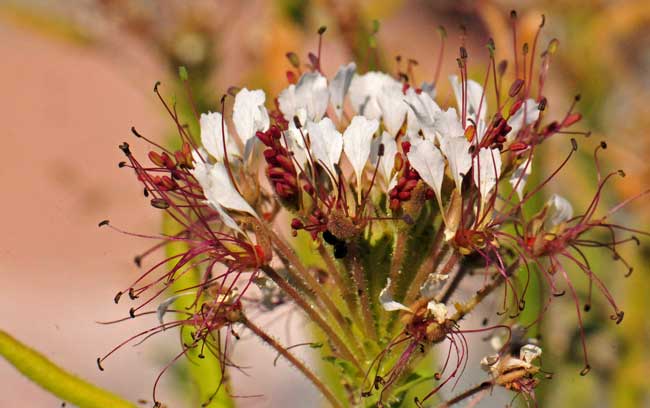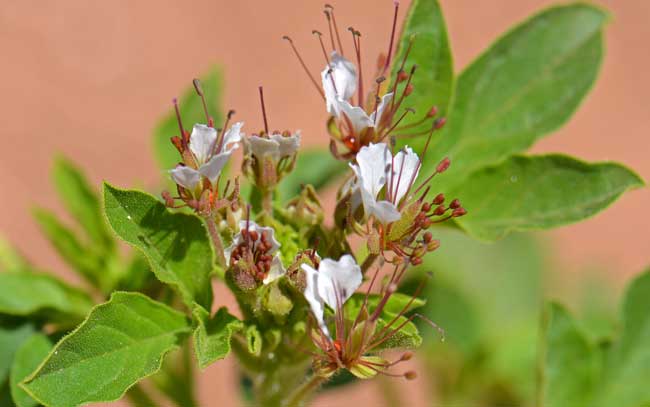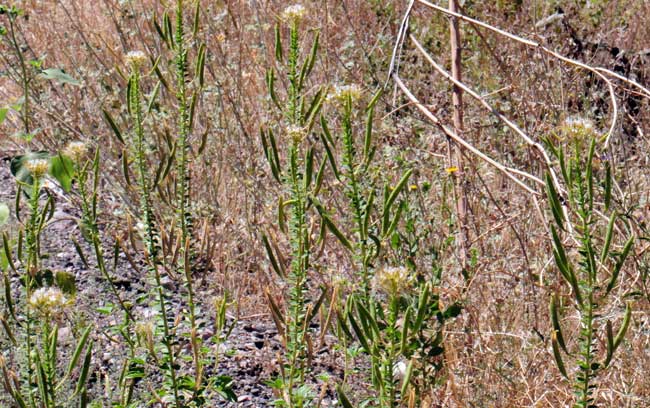Polanisia dodecandra, Redwhisker Clammyweed




Scientific Name: Polanisia dodecandra
Common Name: Redwhisker Clammyweed
Also Called: Clammyweed, Red-whisker Clammyweed, Rio Grande Clammyweed, Roughseed Clammyweed, Sandyseed Clammyweed, Western Clammyweed
Family: Capparaceae (or Capparidaceae), Caper Family
Synonyms: (Cleome dodecandra, Polanisia trachysperma)
Status: Native
Duration: Annual
Size: Up to 2 feet or more.
Growth Form: Forb/herb; stems erect, multiple lateral branches, glandular hair throughout that secret a sticky sap.
Leaves: Green; glandular, palmately compound, distinct petioles, margins entire.
Flower Color: Variable, white, cream, pink or purple; flowers on terminal clusters, stamens are exserted beyond petals, anthers and stigma purple, fruit a capsule, seeds reddish brown.
Flowering Season: May to October.
Elevation: 1,000 to 6,500 feet.
Habitat Preferences: Sandy stream beds, roadsides and disturbed areas.
Recorded Range: Redwhisker Clammyweed is found throughout most of the United States and Canada. It is also native to northern Mexico.
North America & US County Distribution Map for Polanisia dodecandra.
U.S. Weed Information: No data available.
Invasive/Noxious Weed Information: No data available.
Wetland Indicator: Polanisia dodecandra is included on the USDA 2012 National Wetland Plant List. It is listed as a: Facultative Upland (FACU) and Obligate Upland species.
FACU: Usually occur in non-wetlands, but may occur in wetlands.
UPL: Obligate Upland.
Threatened/Endangered Information: The state of Connecticut has listed Polanisia dodecandra a species of Special Concern; the state of Maryland has listed Polanisia dodecandra as Endangered.
Genus Information: 5 species in Polanisia throughout most of the United States, Canada and Mexico.
3 sub-species in Polanisia dodecandra:
Polanisia dodecandra ssp. dodecandra, Redwhisker Clammyweed (found in AZ, most of the US and Canada);
Polanisia dodecandra ssp. riograndensis, Rio Grande Clammyweed (found in TX only) and
Polanisia dodecandra ssp. trachysperma, Sandyseed Clammyweed (found in AZ, most of the US and much of Canada).
Comments: Redwhisker Clammyweed, with its distinct unpleasant odor is common where found in Arizona. It is called Clammyweed because it has glandular hairs that secret a sticky sap.

